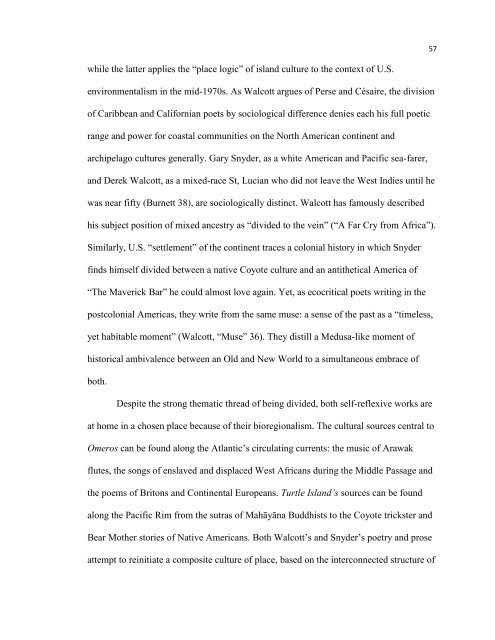RE-INHABITING THE ISLANDS - The University of North Carolina at ...
RE-INHABITING THE ISLANDS - The University of North Carolina at ...
RE-INHABITING THE ISLANDS - The University of North Carolina at ...
You also want an ePaper? Increase the reach of your titles
YUMPU automatically turns print PDFs into web optimized ePapers that Google loves.
57<br />
while the l<strong>at</strong>ter applies the ―place logic‖ <strong>of</strong> island culture to the context <strong>of</strong> U.S.<br />
environmentalism in the mid-1970s. As Walcott argues <strong>of</strong> Perse and Césaire, the division<br />
<strong>of</strong> Caribbean and Californian poets by sociological difference denies each his full poetic<br />
range and power for coastal communities on the <strong>North</strong> American continent and<br />
archipelago cultures generally. Gary Snyder, as a white American and Pacific sea-farer,<br />
and Derek Walcott, as a mixed-race St, Lucian who did not leave the West Indies until he<br />
was near fifty (Burnett 38), are sociologically distinct. Walcott has famously described<br />
his subject position <strong>of</strong> mixed ancestry as ―divided to the vein‖ (―A Far Cry from Africa‖).<br />
Similarly, U.S. ―settlement‖ <strong>of</strong> the continent traces a colonial history in which Snyder<br />
finds himself divided between a n<strong>at</strong>ive Coyote culture and an antithetical America <strong>of</strong><br />
―<strong>The</strong> Maverick Bar‖ he could almost love again. Yet, as ecocritical poets writing in the<br />
postcolonial Americas, they write from the same muse: a sense <strong>of</strong> the past as a ―timeless,<br />
yet habitable moment‖ (Walcott, ―Muse‖ 36). <strong>The</strong>y distill a Medusa-like moment <strong>of</strong><br />
historical ambivalence between an Old and New World to a simultaneous embrace <strong>of</strong><br />
both.<br />
Despite the strong them<strong>at</strong>ic thread <strong>of</strong> being divided, both self-reflexive works are<br />
<strong>at</strong> home in a chosen place because <strong>of</strong> their bioregionalism. <strong>The</strong> cultural sources central to<br />
Omeros can be found along the Atlantic‘s circul<strong>at</strong>ing currents: the music <strong>of</strong> Arawak<br />
flutes, the songs <strong>of</strong> enslaved and displaced West Africans during the Middle Passage and<br />
the poems <strong>of</strong> Britons and Continental Europeans. Turtle Island’s sources can be found<br />
along the Pacific Rim from the sutras <strong>of</strong> Mahāyāna Buddhists to the Coyote trickster and<br />
Bear Mother stories <strong>of</strong> N<strong>at</strong>ive Americans. Both Walcott‘s and Snyder‘s poetry and prose<br />
<strong>at</strong>tempt to reiniti<strong>at</strong>e a composite culture <strong>of</strong> place, based on the interconnected structure <strong>of</strong>
















